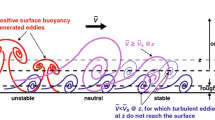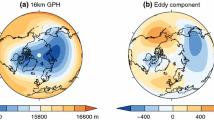Abstract
The forcing of the global circulation is examined using a primitive equation model and a 38-year reanalysis dataset. One-timestep integrations are initialised with selected sets of initial conditions, and the forcing budget for the mean annual cycle is deduced. This budget consists of sources and sinks of momentum, temperature and humidity which are balanced by dynamical terms. The associated timescale interactions are examined in detail. The time-mean forcing is balanced by time-mean fluxes, annual cycle interactions and transient fluxes. The annual cycle of the forcing is balanced by the interaction of annual cycle anomalies with the time-mean flow and with themselves (this latter cycle-cycle interaction term is found to be important for the moisture supply over West Africa). Transient interactions on other timescales also contribute to the forcing of the annual cycle, but the interaction term between the annual cycle and other timescales is small, as is the storage term associated with seasonal tendencies. This objectively derived empirical forcing is then used to drive the dynamical model. The resulting simple GCM is called DREAM (Dynamical Research Empirical Atmospheric Model). This is the first time this approach has been used with an annual cycle. The systematic errors of DREAM compared to the reanalysis chiefly concern the momentum balance in the southern hemisphere jet. Perpetual season simulations are similar to individual seasons from the annual cycle run, consistent with the small seasonal tendency term in the forcing.









Similar content being viewed by others

References
Biasutti M, Battisti DS, Sarachik E (2003) The annual cycle over the tropical atlantic, south america, and africa. J Clim 16(15):2491–2508
Chen YY, Jin FF (2017) Dynamical diagnostics of the sst annual cycle in the eastern equatorial pacific: part ii analysis of cmip5 simulations. Clim Dyn 49(11–12):3923–3936
D’Andrea F, Vautard R (2000) Reducing systematic errors by empirically correcting model errors. Tellus A Dyn Meteorol Oceanogr 52(1):21–41
Danforth CM, Kalnay E, Miyoshi T (2007) Estimating and correcting global weather model error. Mon Weather Rev 135(2):281–299
DelSole T, Hou AY (1999) Empirical correction of a dynamical model. part i: Fundamental issues. Mon Weather Rev 127(11):2533–2545
Fasullo JT, Trenberth KE (2008a) The annual cycle of the energy budget. part i: global mean and land-ocean exchanges. J Clim 21(10):2297–2312
Fasullo JT, Trenberth KE (2008b) The annual cycle of the energy budget. part ii: meridional structures and poleward transports. J Clim 21(10):2313–2325
Hall NMJ (2000) A simple GCM based on dry dynamics and constant forcing. J Atmos Sci 57:1557–1572
Hall NMJ, Derome J (2000) Transience, nonlinearity, and Eddy feedback in the remote response to El Niño. J Atmos Sci 57:3992–4007
Hall NMJ, Douville H, Li L (2013) Extratropical summertime response to tropical interannual variability in an idealized gcm. J Clim 26(18):7060–7079
Hall N, Kiladis G, Thorncroft C (2006) Three dimensional structure and dynamics of African Easterly Waves. part II: dynamical modes. J Atmos Sci 63:2231–2245
Held IM, Suarez MJ (1994) A proposal for the intercomparison of the dynamical cores of atmospheric general circulation models. Bull Am Meteorol Soc 75(10):1825–1830
Horel JD (1982) On the annual cycle of the tropical pacific atmosphere and ocean. Mon Weather Rev 110(12):1863–1878
Hoskins BJ, Simmons AJ (1975) A multi-layer spectral model and the semi-implicit method. Q J R Meteorol Soc 101:637–655
Hsu CPF, Wallace JM (1976) The global distribution of the annual and semiannual cycles in sea level pressure. Mon Weather Rev 104(12):1597–1601
Huang HP, Sardeshmukh PD (2000) Another look at the annual and semiannual cycles of atmosphericangular momentum. J Clim 13(18):3221–3238
Jucker M, Gerber E (2017) Untangling the annual cycle of the tropical tropopause layer with an idealized moist model. J Clim 30(18):7339–7358
Kerr-Munslow A, Norton W (2006) Tropical wave driving of the annual cycle in tropical tropopause temperatures. part i: Ecmwf analyses. J Atmos Sci 63(5):1410–1419
Klinker E, Sardeshmukh PD (1992) The diagnosis of mechanical dissipation in the atmosphere from large-scale balance requirements. J Atmos Sci 49(7):608–627
Leroux S, Hall NMJ (2009) On the relationship between African Easterly Waves and the African Easterly Jet. J Atmos Sci 66:2303–2316
Leroux S, Hall NMJ, Kiladis GN (2011) Intermittent african easterly wave activity in a dry atmospheric model: influence of the extratropics. J Clim 24:5378–5396
Levitus S (1984) Annual cycle of temperature and heat storage in the world ocean. J Phys Oceanogr 14(4):727–746
Lin H, Derome J (1996) Changes in predictability associated with the PNA pattern. Tellus Ser A 48:553-+
Lin H, Derome J, Brunet G (2007) The nonlinear transient atmospheric response to tropical forcing. J Clim 20(22):5642–5665. https://doi.org/10.1175/2007JCLI1383.1
Liu Z (1996) Modeling equatorial annual cycle with a linear coupled model. J Clim 9(10):2376–2385
Marshall J, Molteni F (1993) Toward a dynamical understanding of planetary-scale flow regimes. J Atmos Sci 50:1792–1818
McKinnon KA, Stine AR, Huybers P (2013) The spatial structure of the annual cycle in surface temperature: amplitude, phase, and lagrangian history. J Clim 26(20):7852–7862
Oort AH (1971) The observed annual cycle in the meridional transport of atmospheric energy. J Atmos Sci 28(3):325–339
Oort AH, Vonder Haar TH (1976) On the observed annual cycle in the ocean-atmosphere heat balance over the northern hemisphere. J Phys Oceanogr 6(6):781–800
Peyrillé P, Lafore JP, Boone A (2016) The annual cycle of the west african monsoon in a two-dimensional model: mechanisms of the rain-band migration. Q J R Meteorol Soc 142(696):1473–1489
Roads JO (1987) Predictability in the extended range. J Atmos Sci 44:3495–3527
Sardeshmukh PD, Sura P (2007) Multiscale impacts of variable heating in climate. J Clim 20(23):5677–5695
Schubert S, Chang Y (1996) An objective method for inferring sources of model error. Mon Weather Rev 124(2):325–340
Simmons A, Uppala DD, Kobayashi S (2006) Era-interim: new ecmwf reanalysis products from 1989 onwards. ECMWF Newslett 110:25–36
Sud Y, Walker G, Mehta V, Lau WK (2002) Relative importance of the annual cycles of sea surface temperature and solar irradiance for tropical circulation and precipitation: a climate model simulation study. Earth Interact 6(2):1–32
Thorncroft C, Hall N, Kiladis G (2008) Three dimensional structure and dynamics of African Easterly Waves. Part III: genesis. J Atmos Sci 65:3596–3607
Thorncroft CD, Nguyen H, Zhang C, Peyrille P (2011) Annual cycle of the west african monsoon: regional circulations and associated water vapour transport. Q J R Meteorol Soc 137(654):129–147
Wang B (1994) On the annual cycle in the tropical eastern central pacific. J Clim 7(12):1926–1942
White GH, Wallace JM (1978) The global distribution of the annual and semiannual cycles in surface temperature. Mon Weather Rev 106(6):901–906
Wu Z, Schneider EK, Kirtman BP, Sarachik ES, Huang NE, Tucker CJ (2008) The modulated annual cycle: an alternative reference frame for climate anomalies. Clim Dyn 31(7–8):823–841
Xie SP (1994) On the genesis of the equatorial annual cycle. J Clim 7(12):2008–2013
Yang W, Seager R, Cane MA, Lyon B (2015) The annual cycle of east african precipitation. J Clim 28(6):2385–2404
Acknowledgements
We thank the two anonymous reviewers for comments that led to some clarifications in the manuscript. The forcing budget calculations were carried out by N. Hall while visiting the Department of Atmospheric Sciences, University of Sao Paulo under FAPESP grant 08/58101-9. T. Ambrizzi received support from FAPESP Proc. No. 2017/09659-6.
Author information
Authors and Affiliations
Corresponding author
Appendix: forcing budget definitions and calculations
Appendix: forcing budget definitions and calculations
It is convenient to adopt a more flexible notation for the expansion of Eq. (2). The operation of the dynamical model can be expressed as
where \(\mathsf{\Phi }^{\dagger }\) is the diagonal matrix whose diagonal is formed from elements of the column vector \(\mathbf \Phi\), and \(\mathsf{Q}\) and \(\mathsf{D}\) are real matrices. If \(\mathbf \Phi\) is split into components \(\mathbf X\) and \(\mathbf Y\), the quadratic term \(\mathcal{Q}(\mathbf{X},\mathbf{Y})=\mathsf{X}^{\dagger } \mathsf Q \mathbf Y\) is the column vector with elements \(X_i (\sum _j Q_{ij} Y_j )\). Note that \(\mathcal{Q}(\mathbf{X},\mathbf{X})=\mathcal{A}(\mathbf{X})\) and \(\mathcal{Q}(\mathbf{X},\mathbf{Y}) \ne \mathcal{Q}(\mathbf{Y},\mathbf{X})\).
In this notation the terms in the time mean-annual cycle forcing budget (3) can be written out individually and they are given in Table 1 along with a brief description and a reminder of which component of the forcing \(\mathbf{f}\) they contribute to.
To find all these forcing terms the reanalysis dataset must be sampled in a variety of ways. The dataset \({\varvec{\Phi }}\) consists of 4\(\times\) daily data for 38 years, for a total of 55520 data records. The mean annual cycle \((\overline{\varvec{\Phi }} + \widetilde{\varvec{\Phi }})\) is a 365.25-day dataset consisting of 1461 data records. TEND is calculated directly from this dataset as the cyclic centred difference
All the other terms are formed from one-timestep integrations of the unforced model.
Values of this negative tendency taking various sets of initial conditions from the dataset \({\varvec{\Phi }}_i\) are used to deduce the terms in (3).
Firstly, to find the sum of all the terms in (3) except TEND, the unforced model must be initialised using the entire dataset \(\mathbf{\Phi }_i\). The mean and annual cycle from the resulting set of 55520 one-timestep forecasts, together with TEND, will furnish the forcing \(\overline{\mathbf{f}}+\widetilde{\mathbf{f}}\). This is all that is needed to find a cyclic forcing for a simple GCM.
To break down the forcing into components we proceed as follows:
To find MM, a single integration is needed, with \(\overline{\mathbf{\Phi }}\) as the initial condition. This gives \((\mathcal{A}+\mathcal{D})\overline{\varvec{\Phi }}=\text{ MM }\).
To find the annual cycle contributions MC and CC we use the mean annual cycle \((\overline{\varvec{\Phi }}+\widetilde{\varvec{\Phi }})\) as a set of initial conditions. The negative one-timestep tendencies from these 1461 unforced integrations will deliver MM+MC+CC and since we know MM we can deduce MC+CC.
To separate MC from CC another experiment is required with a set of initial conditions \((\overline{\varvec{\Phi }}+\alpha \widetilde{\mathbf{\Phi }})\). Since \(\mathcal{A}\) is quadratic this will deliver \(\text{ MM }+2\alpha \text{ MC }+\alpha ^2\text{ CC }\) and algebraic elimination with the previous result will provide MC and CC. The value of \(\alpha\) is arbitrary and tests confirm that varying \(\alpha\) does not change the result.
To find the transient contributions CT and TT we use the entire dataset \((\overline{\varvec{\Phi }}+\widetilde{\varvec{\Phi }}+{\varvec{\Phi }}')\) as a set of initial conditions as already discussed above. These 55520 unforced integrations will deliver MM + MC + CC + CT + TT and thence CT+TT. To separate CT from TT another set of initial conditions \((\overline{\varvec{\Phi }}+\widetilde{\varvec{\Phi }}+\alpha {\varvec{\Phi }}')\) is used to get \(\text{ MM }+\text{ MC }+\text{ CC }+2\alpha \text{ CT } + \alpha ^2\text{ TT }\). CT and TT are again deduced by algebraic elimination. Only the mean and annual cycle components of CT and TT are of interest in our budget for \(\overline{\mathbf{f}} + \widetilde{\mathbf{f}}\).
In some of the results the damping and diffusion have been removed, but this is not done by algebraically separating \(\mathcal{D}\) from \(\mathcal{A}\). Instead the model is simply rerun with damping and diffusion switched off and the the same procedure is followed.
Rights and permissions
About this article
Cite this article
Hall, N.M.J., Leroux, S. & Ambrizzi, T. Transient contributions to the forcing of the atmospheric annual cycle. Clim Dyn 52, 6719–6733 (2019). https://doi.org/10.1007/s00382-018-4539-y
Received:
Accepted:
Published:
Issue Date:
DOI: https://doi.org/10.1007/s00382-018-4539-y



